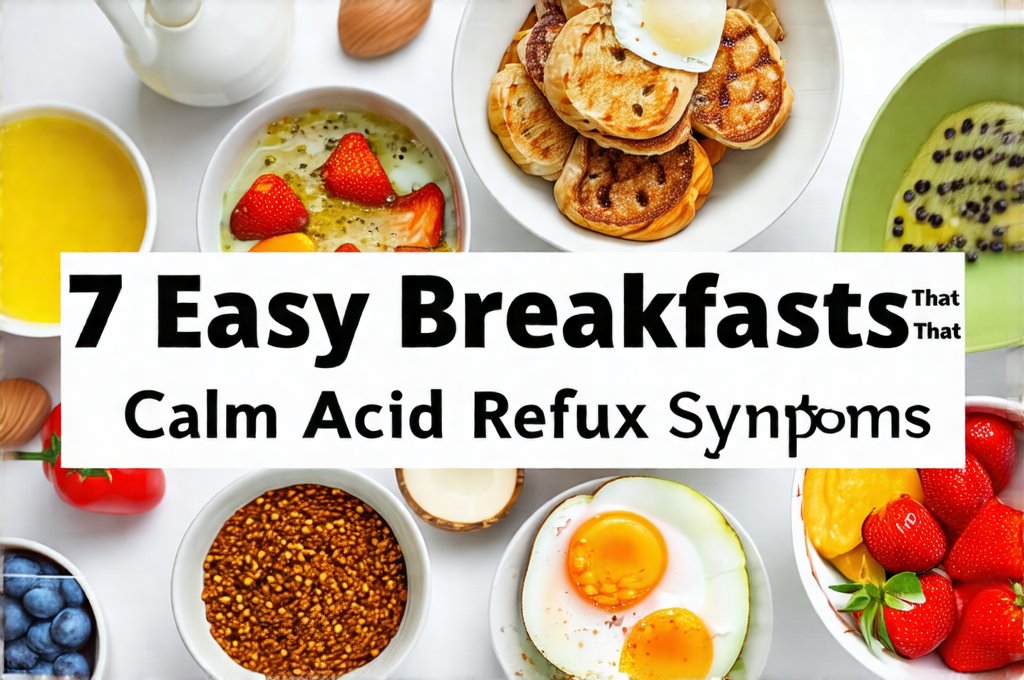Acid reflux is a frustrating condition affecting millions, often starting with seemingly innocuous symptoms like heartburn or indigestion. However, for many, these symptoms can escalate into chronic discomfort, disrupting daily life and impacting overall well-being. The connection between what we eat and the severity of acid reflux is undeniable; certain foods trigger flare-ups while others offer soothing relief. A significant component in managing this condition lies in understanding how to choose breakfast options that minimize irritation and promote digestive health. Often overlooked, the first meal of the day sets the tone for your entire digestive system – making it a crucial point of intervention when dealing with acid reflux.
This isn’t about strict dietary restrictions or eliminating all enjoyable foods. It’s about making informed choices that support a calmer digestive experience. Many people find they can still enjoy a wide range of foods, even those traditionally considered “triggering,” by adjusting portion sizes, cooking methods, and combining them with less acidic options. The following breakfast ideas are designed to be gentle on the stomach, focusing on easily digestible ingredients and minimizing factors that contribute to acid production or esophageal irritation. Remember, individual tolerances vary, so pay attention to your body’s responses and adjust accordingly.
Gentle Beginnings: Breakfast Strategies for Acid Reflux Relief
The key to a reflux-friendly breakfast isn’t necessarily what you eat, but how you approach it. Focus on smaller portions; overwhelming the stomach with large quantities of food can increase pressure and push acid upwards. Slow, mindful eating is also critical – savor each bite and thoroughly chew your food. This aids digestion and reduces the burden on your digestive system. Finally, consider timing: eating breakfast at least 2-3 hours before lying down allows gravity to assist in keeping stomach contents where they belong. Avoid immediately vigorous physical activity after breakfast as it can increase abdominal pressure.
Beyond these general principles, ingredient selection is paramount. Highly acidic foods like citrus fruits and tomatoes should be consumed cautiously or avoided altogether if you find they exacerbate your symptoms. Fatty foods are also problematic as they delay gastric emptying, increasing the risk of reflux. Instead, prioritize bland, easily digestible options that won’t overburden your system. Oatmeal, bananas, melon, and whole-wheat toast are excellent starting points. Incorporating probiotics through yogurt or kefir (if tolerated) can support gut health and potentially reduce inflammation which could play a role in acid reflux symptoms. It’s important to understand how to interpret gut sensations that may precede discomfort, too.
It’s important to remember the significant role of hydration. Drinking water throughout the day, including with breakfast, helps dilute stomach acid and promotes proper digestion. However, avoid drinking large amounts of liquid during your meal; this can distend the stomach and increase pressure. Sip small amounts of water between bites instead. A personalized approach is crucial – keeping a food diary to track which foods trigger your symptoms will empower you to make informed decisions about your diet and create a breakfast routine that works for you. Understanding why your acid reflux symptoms fluctuate can also help tailor your approach.
Soothing Options: Seven Breakfast Ideas
Here are seven easy breakfast options tailored for those seeking relief from acid reflux, offering a balance of nutrition and digestive comfort.
- Oatmeal with Banana & Almond Butter: Oatmeal is naturally soothing to the stomach due to its high fiber content. Bananas are low-acidic and provide potassium, while almond butter adds healthy fats and protein for sustained energy. Avoid adding excessive sugar or dairy if you’re sensitive to either.
- Whole-Wheat Toast with Avocado & a Sprinkle of Sea Salt: Whole-wheat toast provides complex carbohydrates and fiber. Avocado is rich in healthy fats and gentle on the stomach, while sea salt enhances flavor without irritating your esophagus.
- Poached Egg on Whole-Wheat Toast: Eggs are a great source of protein, but frying them can add unnecessary fat. Poaching keeps it light and easily digestible. Use whole wheat toast for added fiber.
- Greek Yogurt with Melon & Honey (small amount): Greek yogurt provides probiotics and protein. Melon is low-acidic and hydrating, while a small drizzle of honey adds natural sweetness. Choose plain, unsweetened Greek yogurt to avoid added sugars.
- Smoothie with Banana, Spinach & Almond Milk: Smoothies are easy to digest and can be customized to your preferences. Banana provides potassium, spinach offers vitamins and minerals, and almond milk is generally well-tolerated. Avoid adding citrus fruits or acidic berries. Comforting grain-based meals could also be good options to incorporate.
- Rice Porridge (Congee): This traditional Asian breakfast is incredibly gentle on the stomach. Rice porridge is easily digestible and soothing, making it a great option for sensitive systems. You can add small amounts of cooked chicken or vegetables for added nutrition.
- Applesauce with Cinnamon: Applesauce provides fiber and pectin, which can help regulate digestion. Cinnamon adds flavor without acidity. Ensure the applesauce is unsweetened to avoid adding unnecessary sugar.
Identifying Your Personal Triggers
One of the most important steps in managing acid reflux is identifying your personal trigger foods. What causes symptoms for one person may not affect another. A food diary is an invaluable tool for this process. – Record everything you eat and drink, including portion sizes. – Note the time of day you consume each item. – Track any symptoms that arise, including heartburn, indigestion, bloating, or regurgitation. – Pay attention to the timing of your symptoms relative to what you ate.
Over time, patterns will emerge, revealing which foods consistently trigger your reflux. Common culprits include: – Citrus fruits and juices (orange, grapefruit, lemon) – Tomatoes and tomato-based products – Chocolate – Coffee and caffeinated beverages – Alcohol – Fatty foods – Spicy foods – Mint Once you’ve identified your triggers, you can begin to modify your diet accordingly. This doesn’t necessarily mean eliminating these foods entirely; it may simply involve reducing portion sizes or avoiding them at certain times of the day. Easy weeknight dinners can also be planned with trigger avoidance in mind.
The Role of Hydration & Meal Timing
Staying adequately hydrated is crucial for digestive health and can help neutralize stomach acid. Aim for at least eight glasses of water per day, but avoid drinking large amounts during meals. Instead, sip small amounts of water between bites to keep your mouth moist and aid in digestion. Water helps dilute stomach acid and supports the efficient movement of food through the digestive tract. Herbal teas like chamomile or ginger can also be soothing, but avoid peppermint tea as it may relax the lower esophageal sphincter, potentially worsening reflux.
Meal timing is another significant factor. Eating too close to bedtime increases the risk of nighttime reflux, as gravity isn’t working in your favor. Aim to finish eating at least 2-3 hours before lying down. Smaller, more frequent meals can also be beneficial, as they put less strain on your digestive system than large, infrequent ones. Avoid rushing through meals – slow, mindful eating allows for proper chewing and digestion, reducing the likelihood of symptoms. How to handle reflux with nausea is also important to be aware of.
Lifestyle Adjustments Beyond Breakfast
While breakfast choices play a vital role, managing acid reflux requires a holistic approach that encompasses broader lifestyle adjustments. – Maintain a healthy weight: Excess weight puts pressure on your abdomen, increasing the risk of reflux. – Elevate the head of your bed: Raising the head of your bed by 6-8 inches can help prevent nighttime reflux. – Avoid tight-fitting clothing: Tight clothes constrict your abdomen and increase pressure. – Manage stress: Stress can exacerbate acid reflux symptoms; practice relaxation techniques like yoga or meditation. – Quit smoking: Smoking weakens the lower esophageal sphincter, increasing the risk of reflux. – Limit alcohol consumption: Alcohol relaxes the lower esophageal sphincter and increases stomach acid production. Remember to consult with a healthcare professional for personalized advice and treatment options if your acid reflux symptoms are severe or persistent. Top cooking oils can also influence symptom severity.


















